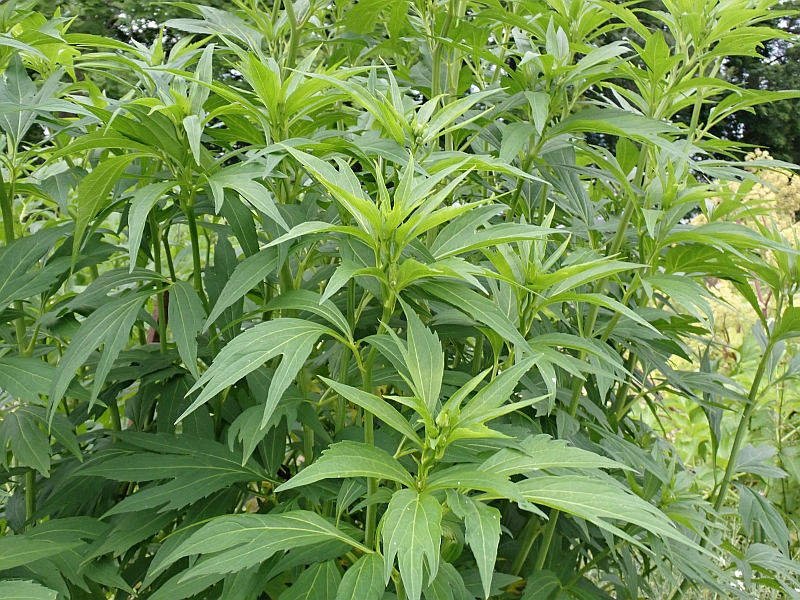When giving talks I like to renew myself and talk about something different each time. For my talk in Copenhagen at the Future Heirloom event last weekend I focussed during part of my presentation on edimentals in the Asteraceae or Compositae (the aster or daisy family / kurvplantefamilien). These are tbe edible perennial vegetables that are most obvious in the autumn garden and often underutilised by chefs in the west. Visiting the World Garden a few days before my talk on 17th October, I gathered flowers from all the flowering Asteraceae and here they are with names: Most are used for their tasty spring shoots and leaves, used cooked and raw, and most have a characteristic fragrant taste / aroma loved in the Far East (as also Chrysanthemum tea is popular and a refreshing accompaniment to spicy dishes). Aster scaber and Ligularia fischeri are nowadays both cultivated in a big way as “sannamul” in Korea and even exported to Korean markets around the world. Young shoots of other Aster sp. are foraged in Asia as is big-leaf Aster, Aster macrophyllus, in North America. Also from North America, cutleaf coneflower Rudbeckia laciniata or sochan was a popular vegetable for the Cherokee first people and in recent years has, maybe not unsurprisingly become a commercial vegetable in Korea. Annual shungiku or chopsuey greens Glebionis coronaria hails from the Mediterranean but is today an important vegetable in the Far East! Others currently in flower are best known as root crops, including (in the picture) Jerusalem artichoke (Helianthus tuberosus) and Dahlia. Yacon (Polymnia sonchifolia) is also autumn flowering but doesn’t manage to flower here (is moved indoors to flower and bulk up). The final flower in the picture is marigold Calendula officinalis, whose culinary use includes decorating and flavouring salads, soups and other dishes.
Most are used for their tasty spring shoots and leaves, used cooked and raw, and most have a characteristic fragrant taste / aroma loved in the Far East (as also Chrysanthemum tea is popular and a refreshing accompaniment to spicy dishes). Aster scaber and Ligularia fischeri are nowadays both cultivated in a big way as “sannamul” in Korea and even exported to Korean markets around the world. Young shoots of other Aster sp. are foraged in Asia as is big-leaf Aster, Aster macrophyllus, in North America. Also from North America, cutleaf coneflower Rudbeckia laciniata or sochan was a popular vegetable for the Cherokee first people and in recent years has, maybe not unsurprisingly become a commercial vegetable in Korea. Annual shungiku or chopsuey greens Glebionis coronaria hails from the Mediterranean but is today an important vegetable in the Far East! Others currently in flower are best known as root crops, including (in the picture) Jerusalem artichoke (Helianthus tuberosus) and Dahlia. Yacon (Polymnia sonchifolia) is also autumn flowering but doesn’t manage to flower here (is moved indoors to flower and bulk up). The final flower in the picture is marigold Calendula officinalis, whose culinary use includes decorating and flavouring salads, soups and other dishes.
Late flowering also means that the Asteraceae are also particularly important for a range of insect pollinators like hoverflies, drone flies and bees as can be seen in the pictures below, all taken in the World Garden:
Tag Archives: cutleaf coneflower
Sochan tops Mediterranean style
Thanks to Alan Bergo (@foragerchef) for reminding me to try sochan tops. This is Rudbeckia laciniata (cut-leafed coneflower) which in the double form is one of the most popular garden ornamentals here in Norway over the last 100 years and a plant that has been commercialised as a farm vegetable over recent years in Korea. I’d previously only eaten the spring shoots, but I was equally impressed by the tops which I used simply cooked with onion, garlic and yellow zucchini from the garden, various fungi picked in the woods (saffron milkcap/matriske; hedgehog fungus / piggsopp and chantarelles / kantarell) and scrambled with eggs with a little chilim added (a classic way for preparing wild edibles in the Mediterranean countries. See the pictures below.
See other posts on this great vegetable which was introduced to me in one of Samuel Thayer’s books:
Appalachian Greens
Cherokee Pizza 




























